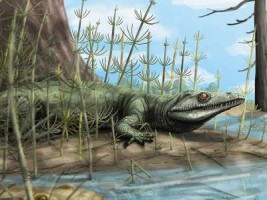
A team of anthropologists partnering with Universities in Basil and UK have discovered a new species of reptile previously unrecorded. The fossil dates back nearly 250 million years and was discovered at the tip of Rio Grande do Sul, the southernmost state in Brazil. The discoverers have named the new species “Teyujagua paradoxa” meaning ‘fierce lizard’ – named after the mythological beast Teju Jagau. The species is said to be a close descendant of dinosaurs, crocodiles and birds whom went on to re-populate the Earth.
If you were unaware, the extinction of the dinosaurs was not the first extinction to occur on Earth. Before the time of the dinosaurs there was something known as the Permian-Triassic Extintion, an event theorized to be caused after a violent string of volcanic eruptions. Whatever happened caused nearly 90% of all life on Earth to become extinct at one geologic point in time. As mentioned earlier this skeleton was discovered from 250 million years ago. The Permian extinction occurred 252 million years ago. This is what makes the new fossil discovery so special. This fossil gives scientist a unique window to observe how life forms changed (evolved) immediately following in the wake of a mass extinction event.
“The discovery of Teyujagua was really exciting. Ever since we saw that beautiful skull for the first time in the field, still mostly covered by rock, we knew we had something extraordinary in our hands. Back in the lab, after slowly exposing the bones, the fossil exceeded our expectations, it had a combination of features never seen before, indicating the unique position of Teyujagua in the evolutionary tree of an important group of vertebrates. Teyujagua is different from other fossils from the same era.” – Dr Felipe Pinheiro, from Universidade Federal do Pampa –
Now that the reptile has been unearthed scientists can now speculate about its lifestyle and habits. Teyujagua is anticipated to be a small reptile species in compared to the dinosaurs to follow or the alligators we see today. They are estimated to reach 5 feet in length when fully matured. Similar to modern crocodiles the reptile has nostrils located at the top of its snout and is said to have slightly curved, pointed teeth with fine serrations. This indicates the reptile consumed a carnivorous diet. As the fossil was found near a large body of water, Teyujagua likely lived in lakes and rivers, hunting amphibians and other small body animals.

** The teams complete findings are set to be published in the upcoming issue of Scientific Reports Journal
Read More: http://www.eurekalert.org/pub_releases/2016-03/uob-pd2031016.php
This article (New Species Discovered | 250 Million Year Old Reptile Skeleton Unearthed In Brasil) is free and open source. You have permission to republish this article using a creative commons license with attribution to the author and AnonHQ. Join the conversation at www.anonboards.com




